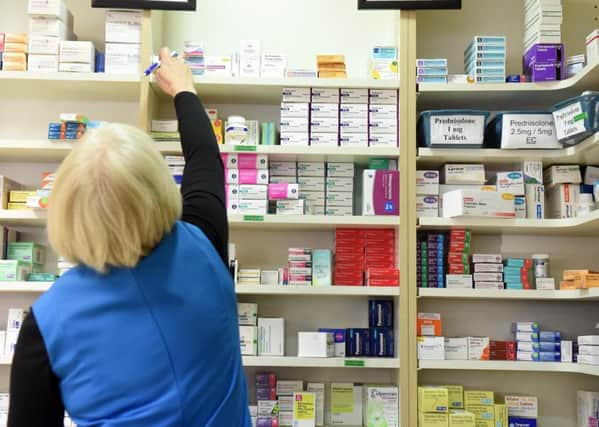Bill for prescriptions in Scotland rises by 25% in the last decade to £1.3bn


New figures from NHS Scotland also show paracetamol and aspirin are among the most commonly dispensed medications in the country.
The total bill for prescriptions represents an increase of 3.3 per cent on the previous year and is 25.7 per cent more expensive than ten years ago. The overall cost amounted to almost £250 per person in Scotland.
Advertisement
Hide AdAdvertisement
Hide AdThe cost of prescriptions has been covered by taxpayers in Scotland since April 2011, a policy introduced by the SNP government. Opposition parties last night criticised the Scottish Government over the rising bill.
Scottish Conservative health spokesman Miles Briggs accused the SNP of “total mismanagement” of the health service, while Labour called for additional funding in the NHS.
The latest figures showed 103.4 million items were dispensed on prescription in 2017-18 – a 20.5 per cent increase from the total of 85.8 million items ten years ago.
Pregabalin, used to treat epilepsy and chronic pain, had the highest total gross ingredient cost in 2017-18, at £36.38 million.
Advertisement
Hide AdAdvertisement
Hide AdMeanwhile, the most commonly prescribed medication was omeprazole – which is used to treat indigestion, acid reflux and stomach ulcers – with a total of 3.59 million prescriptions being issued.
Painkillers paracetamol and aspirin – both of which are also available over the counter without a prescription – were the fourth and eighth most commonly issued prescriptions, at 2.5 million and 2.01 million respectively.
Reasons for the increase in the number of prescriptions issued over the decade include an ageing population and more people living with long-term conditions, the NHS report said.
The report stated: “The volume and cost of dispensed medicines and provision of pharmacy services within the community in Scotland has increased over the last ten years due to a range in factors, including an aging population, newly available drugs and a shift from secondary to primary care for a number of high-cost medicines.”
Advertisement
Hide AdAdvertisement
Hide AdAcross Scotland as a whole, the amount spent on prescriptions amounted to an average of £248.79 for 2017-18. But the figures vary widely by area.
In the NHS Greater Glasgow and Clyde area – which is Scotland’s largest health board – that figure rose to £271.30 per person, while NHS Orkney had the lowest average cost at £206.28 per person.
Mr Briggs added: “Given the financial strain our NHS is already under, it’s concerning to see the cost of prescriptions rising further.
“With drugs such as paracetamol and aspirin often cheaper to purchase over the counter, we need to ensure that we are getting value for money for our NHS.”
Advertisement
Hide AdAdvertisement
Hide AdMeanwhile, Scottish Labour health spokesman Anas Sarwar said: “As more Scots continue to live longer, prescription costs are almost bound to rise due to more people living with long-term conditions that require treatment.
“This presents challenges not only for prescriptions but for a range of other services such as social care and GP practices.
“The SNP government is not rising to meet these challenges currently.
“Nursing vacancies are on the rise and more GP practices are closing their lists showing the strain on already under-resourced staff.”
Advertisement
Hide AdAdvertisement
Hide AdHealth Secretary Jeane Freeman said the increase in costs for drugs dispensed in the community is “in line” with the anticipated trend and reflects the fact that more patients are being treated closer to home with specialist medicines traditionally reserved for hospital use.
She added: “These new treatments deliver better outcomes for patients and are best value for money for the NHS. However, we expect NHS Scotland to always look for opportunities to work with pharmaceutical companies to reduce the cost for drugs wherever possible.
“Supply issues, an ageing population, increasingly complex health care needs, more people living with long-term conditions, and the impact of the volatility in the value of the pound in recent years are also contributory factors to increased costs.”
But she also said: “Legislation controlling what the NHS pays for medicines and supplies is currently reserved to the UK government and we are continuing to press them to ensure we can get best value.”
Advertisement
Hide AdAdvertisement
Hide AdIn May, The Scotsman’s sister paper Scotland on Sunday revealed that the country’s 14 health boards have spent more than £57m on providing free paracetamol alone since charging for prescriptions was scrapped by the SNP government in 2011.
Before it was abolished in 2011, the £3 prescription charge raised £57m for the health service in Scotland.
At present a charge of £8.80 is made for each item on prescription on the NHS in England, although some people are exempt because of their age, income or medical condition.
Free prescriptions are seen as a tool to reduce health inequalities and a way to ensure people with long-term conditions are able to keep taking their medicines.
Under devolution, Wales was the first part of the UK to make prescriptions free, in 2007. Northern Ireland followed in 2010.
